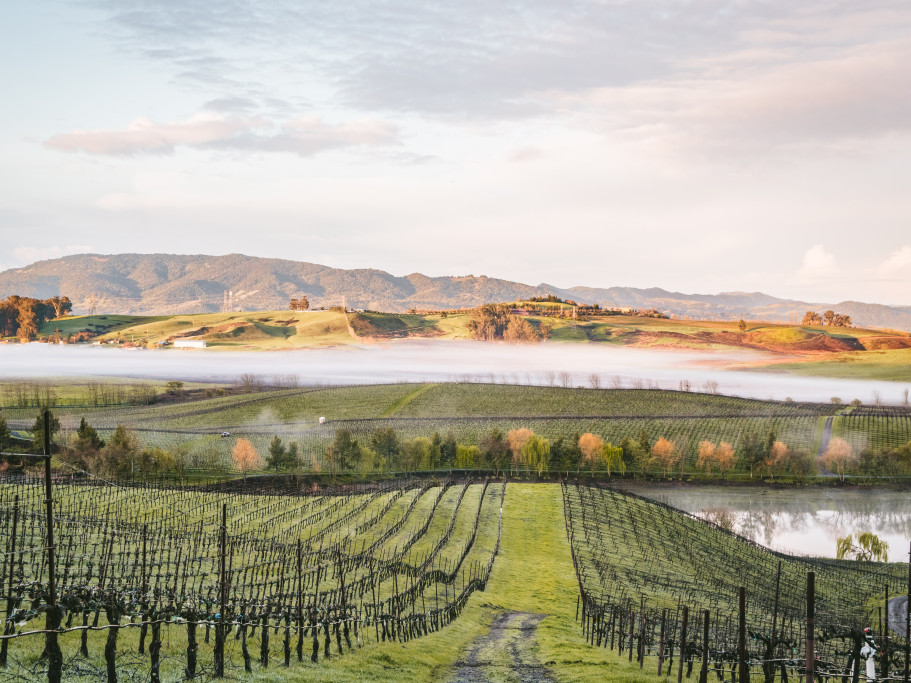Growing in the Wind
By Virginie Boone
It took until January 8, 2018, for the Alcohol and Tobacco Tax and Trade Bureau (TTB) to finalize the Petaluma Gap as an official American Viticultural Area (AVA) after a determined group of vintners and winegrowers spent years trying to get it through.
The official petition was sent from Patrick L. Shabram on behalf of the Petaluma Gap Winegrowers Alliance (PGWA), representing 80 commercially producing vineyards covering about 4,000 acres and nine bonded wineries.
Shabram is a Colorado-based geographic consultant who specializes in AVAs and has done research and consulting work across much of Sonoma County, as well as in other wine regions in California, Texas and Oregon. Russian River Valley viticulture was the subject of his master’s thesis at San Jose State.
Shabram worked closely with Doug Cover, now an emeritus board member of the PGWA. A graduate of Penn State and resident of Petaluma since 1994, Cover was a wine enthusiast whose growing interest led to viticulture and winemaking classes at Santa Rosa Junior College. Soon enough, he and his wife were planting grapes on their 3-acre property that had once been grazing land. They made Syrah from 1998 until selling the property in 2018, entering and winning home wine competitions along the way.
Cover joined the PGWA in 2008, recruited by Timo Rivetti and Paul Clary. As he describes in an interview, the turning point for getting official approval for the AVA came when the TTB began disallowing the use of the term “Petaluma Gap” on the back labels of some wines because the TTB considered it a term of “viticultural significance.”
“So, we were faced with either accepting a ‘one step backward’ situation or proceeding with a petition to become an official AVA,” he said.
With the help of vintner Ana Keller of Keller Estate, the group held an open invitation meeting in February 2014 with growers and stakeholders in the area to discuss the pros and cons of proceeding with an AVA petition.
“We all pretty much knew that the key distinction was the frequency and intensity of the afternoon winds during the growing season,” Cover added.
In the end, the Petaluma Gap AVA designated 202,476 existing acres across Sonoma County and Marin County out of the larger North Coast and Sonoma Coast AVAs with the Gap itself giving the new appellation its meaning, a significant 15-mile-wide opening in the coastal mountain range that brings in cold air.
The distinguishing features of the AVA are its topography and wind speeds. As described in the petition to the TTB: “The terrain consists of highlands characterized by low, rolling hills not exceeding 600 feet, except in a few places within the ridgelines that form the proposed northern, eastern and southern boundaries.”
“The low elevations and gently rolling terrain,” it continued, “create a corridor that allows marine winds to flow relatively unhindered from the Pacific Ocean to San Pablo Bay, particularly during the mid-to-late afternoon. As a result, cool air and marine fog enter the vineyards during the time of day when temperatures would normally be at their highest, bringing heat relief to the vines.”
It added that the Gap not only allows marine air to enter, it also enters at higher speeds than found in surrounding areas, “where higher, steeper mountains disrupt the flow of air.”
Further spelled out was what happens specifically to the grapes grown in the Petaluma Gap AVA. The effect of these prolonged high wind speeds is a reduction in photosynthesis “to the extent that the grapes have to remain on the vine longer in order to reach a given sugar level (longer hang time), compared to the same grape varietal grown in a less windy location.”
The TTB allowed the partial overlap of the Petaluma Gap AVA with the Sonoma Coast AVA but kept the Marin County portion outside the Sonoma Coast. All told, about three-quarters of the grapes grown are Pinot Noir, with most of the remaining acreage planted to Chardonnay and Syrah.
Winemakers have praised the Petaluma Gap’s ability to grow grapes that make wines that balance fruit and structure, wines that are deep and dense and yet able to maintain delicate floral and fruit characteristics.
To celebrate its unique grapegrowing circumstances and the wines that result, the PGWA will hold its annual Wind to Wine Festival on Saturday, August 10, at the Gambonini Family Ranch on Petaluma’s Old Lakeville Road.
Frank and Stacey Gambonini are fifth-generation farmers who celebrated their 100th year as a dairy in 2013. Once known as Gamlake Dairy, the 500-acre ranch includes rolling hills with 200 head of cattle that was converted to organic in 2007 and includes a historic hay barn. The milking operation ended in 2019, but the family continues to raise organic dairy heifers. It has been awarded Dairy of the Year and Farm Family of the Year awards from the Sonoma County Farm Bureau.
During the festival, wines will be poured from such wineries as Anaba, Bevan Cellars, Cline Family Cellars, Gust Wines, Keller Estate, Lombardi Wines, MacRostie, Patz & Hall, Ron Noble, Sangiacomo and Trombetta Family Wines, among others, with bites from Girl & The Fig.
There is also the option to take a vineyard walk on Friday, August 9, at Panther Ridge in Penngrove from 10 a.m. to 11:30 a.m., a 7-acre vineyard on Sonoma Mountain.
On Saturday, two seated tasting seminars are also planned for VIP guests. The first, Petaluma Gap Winemakers and Burgundy, will feature Pinot Noir and Chardonnay wines from both regions, while the second, Pinot Noir from Two Iconic Vineyards, will highlight an array of wines made from Sangiacomo Roberts Road and Gap’s Crown.
Get out and feel the wind.
Image by the Petaluma Gap Winegrowers Alliance.


